four wheel drive Seat Altea XL 2009 Owner's Manual
[x] Cancel search | Manufacturer: SEAT, Model Year: 2009, Model line: Altea XL, Model: Seat Altea XL 2009Pages: 297, PDF Size: 9.36 MB
Page 186 of 297
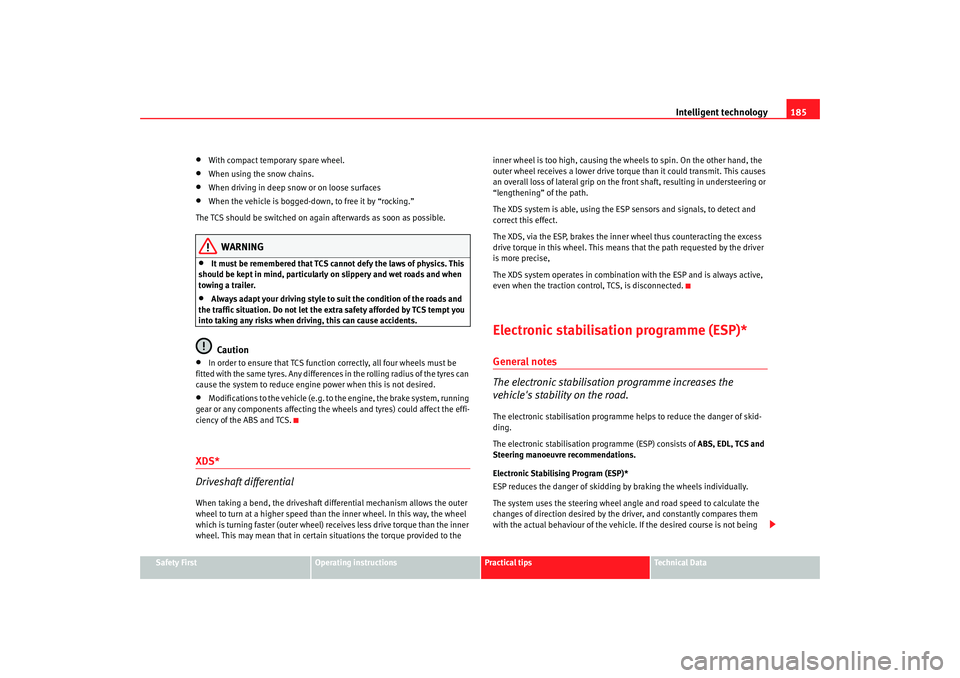
Intelligent technology185
Safety First
Operating instructions
Practical tips
Te c h n i c a l D a t a
•
With compact temporary spare wheel.
•
When using the snow chains.
•
When driving in deep snow or on loose surfaces
•
When the vehicle is bogged-down, to free it by “rocking.”
The TCS should be switched on again afterwards as soon as possible.
WARNING
•
It must be remembered that TCS cann ot defy the laws of physics. This
should be kept in mind, particular ly on slippery and wet roads and when
towing a trailer.
•
Always adapt your driving style to suit the condition of the roads and
the traffic situation. Do not let the extra safety afforded by TCS tempt you
into taking any risks when driving, this can cause accidents.Caution
•
In order to ensure that TCS function correctly, all four wheels must be
fitted with the same tyres. Any differences in the rolling radius of the tyres can
cause the system to reduce engine power when this is not desired.
•
Modifications to the vehicle (e.g. to the engine, the brake system, running
gear or any components affecting the wh eels and tyres) could affect the effi-
ciency of the ABS and TCS.
XDS*
Driveshaft differentialWhen taking a bend, the driveshaft differential mechanism allows the outer
wheel to turn at a higher speed than the inner wheel. In this way, the wheel
which is turning faster (outer wheel) receives less drive torque than the inner
wheel. This may mean that in certain situations the torque provided to the inner wheel is too high, causing the wheels to spin. On the other hand, the
outer wheel receives a lower drive torque than it could transmit. This causes
an overall loss of lateral grip on the front shaft, resulting in understeering or
“lengthening” of the path.
The XDS system is able, using the ESP sensors and signals, to detect and
correct this effect.
The XDS, via the ESP, brakes the inner wheel thus counteracting the excess
drive torque in this wheel. This means that the path requested by the driver
is more precise,
The XDS system operates in combination with the ESP and is always active,
even when the traction control, TCS, is disconnected.
Electronic stabilisation programme (ESP)*General notes
The electronic stabilisation programme increases the
vehicle's stability on the road.The electronic stabilisation programme helps to reduce the danger of skid-
ding.
The electronic stabilisation programme (ESP) consists of
ABS, EDL, TCS and
Steering manoeuvre recommendations.
Electronic Stabilising Program (ESP)*
ESP reduces the danger of skidding by braking the wheels individually.
The system uses the steering wheel angle and road speed to calculate the
changes of direction desired by the driver, and constantly compares them
with the actual behaviour of the vehi cle. If the desired course is not being
AlteaXL_EN.book Seite 185 Montag, 2. Februar 2009 12:26 12
Page 187 of 297
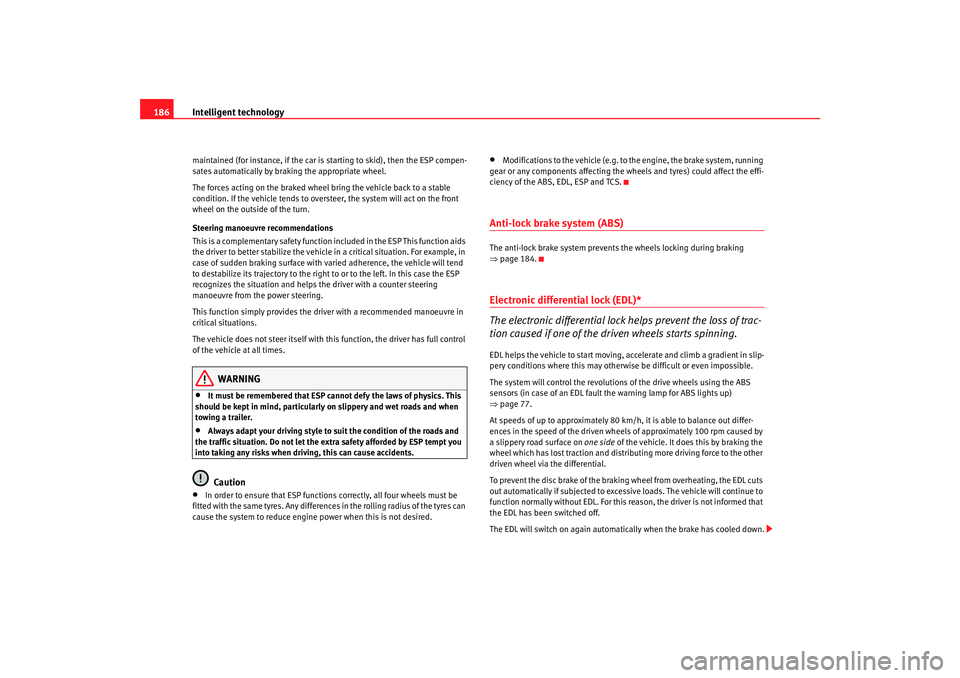
Intelligent technology
186maintained (for instance, if the car is starting to skid), then the ESP compen-
sates automatically by braking the appropriate wheel.
The forces acting on the braked wheel bring the vehicle back to a stable
condition. If the vehicle tends to oversteer, the system will act on the front
wheel on the outside of the turn.
Steering manoeuvre recommendations
This is a complementary safety function included in the ESP This function aids
the driver to better stabilize the vehicle in a critical situation. For example, in
case of sudden braking surface with varied adherence, the vehicle will tend
to destabilize its trajectory to the right to or to the left. In this case the ESP
recognizes the situation and helps the driver with a counter steering
manoeuvre from the power steering.
This function simply provides the driver with a recommended manoeuvre in
critical situations.
The vehicle does not steer itself with this function, the driver has full control
of the vehicle at all times.
WARNING
•
It must be remembered that ESP cannot defy the laws of physics. This
should be kept in mind, particularly on slippery and wet roads and when
towing a trailer.
•
Always adapt your driving style to suit the condition of the roads and
the traffic situation. Do not let the extra safety afforded by ESP tempt you
into taking any risks when driv ing, this can cause accidents.Caution
•
In order to ensure that ESP functions correctly, all four wheels must be
fitted with the same tyres. Any differences in the rolling radius of the tyres can
cause the system to reduce engine power when this is not desired.
•
Modifications to the vehicle (e.g. to the engine, the brake system, running
gear or any components affecting the wheels and tyres) could affect the effi-
ciency of the ABS, EDL, ESP and TCS.
Anti-lock brake system (ABS)The anti-lock brake system prevents the wheels locking during braking
⇒ page 184.Electronic differential lock (EDL)*
The electronic differential lock helps prevent the loss of trac-
tion caused if one of the driven wheels starts spinning.EDL helps the vehicle to start moving, accelerate and climb a gradient in slip-
pery conditions where this may otherwise be difficult or even impossible.
The system will control the revolutions of the drive wheels using the ABS
sensors (in case of an EDL fault th e warning lamp for ABS lights up)
⇒ page 77.
At speeds of up to approximately 80 km/h, it is able to balance out differ-
ences in the speed of the driven wheels of approximately 100 rpm caused by
a slippery road surface on one side of the vehicle. It does this by braking the
wheel which has lost traction and distributing more driving force to the other
driven wheel via the differential.
To prevent the disc brake of the braking wheel from overheating, the EDL cuts
out automatically if subjected to excessive loads. The vehicle will continue to
function normally without EDL. For this reason, the driver is not informed that
the EDL has been switched off.
The EDL will switch on again automatically when the brake has cooled down.
AlteaXL_EN.book Seite 186 M ontag, 2. Februar 2009 12:26 12
Page 188 of 297
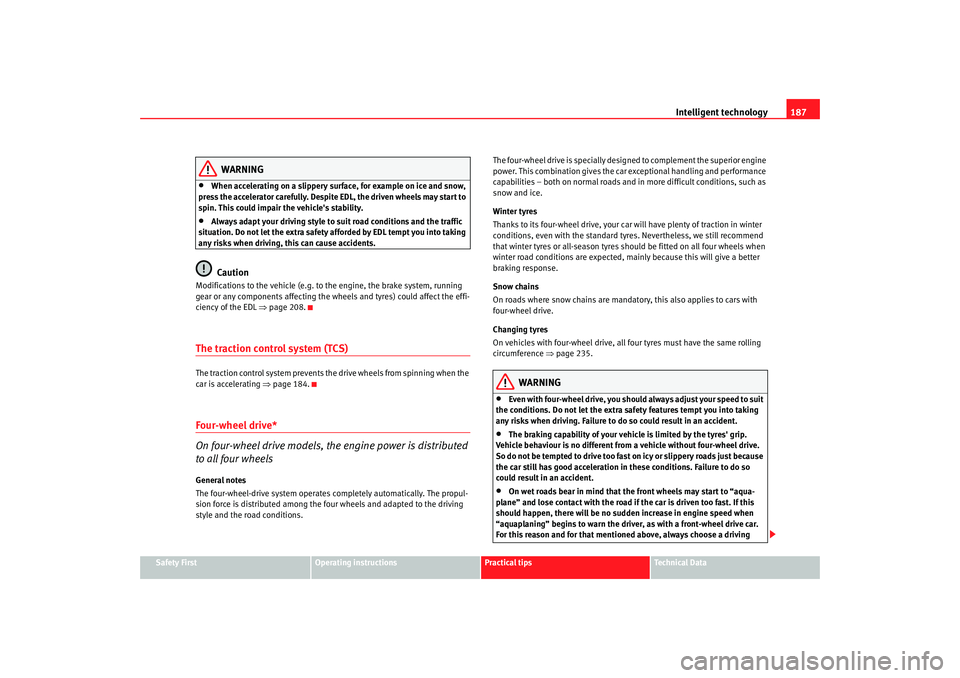
Intelligent technology187
Safety First
Operating instructions
Practical tips
Te c h n i c a l D a t a
WARNING
•
When accelerating on a slippery surface, for example on ice and snow,
press the accelerator carefully. Despite EDL, the driven wheels may start to
spin. This could impair the vehicle's stability.
•
Always adapt your driving style to suit road conditions and the traffic
situation. Do not let the extra safety afforded by EDL tempt you into taking
any risks when driving, this can cause accidents.Caution
Modifications to the vehicle (e.g. to the engine, the brake system, running
gear or any components affecting the wh eels and tyres) could affect the effi-
ciency of the EDL ⇒ page 208.The traction control system (TCS)The traction control system prevents th e drive wheels from spinning when the
car is accelerating ⇒page 184.Four-wheel drive*
On four-wheel drive models, the engine power is distributed
to all four wheelsGeneral notes
The four-wheel-drive system operates completely automatically. The propul-
sion force is distributed among the four wheels and adapted to the driving
style and the road conditions. The four-wheel drive is specially designed to complement the superior engine
power. This combination gives the car exceptional handling and performance
capabilities – both on normal roads and in more difficult conditions, such as
snow and ice.
Winter tyres
Thanks to its four-wheel drive, your car will have plenty of traction in winter
conditions, even with the standard tyres. Nevertheless, we still recommend
that winter tyres or all-season tyres sh
ould be fitted on all four wheels when
winter road conditions are expected, mainly because this will give a better
braking response.
Snow chains
On roads where snow chains are mandatory, this also applies to cars with
four-wheel drive.
Changing tyres
On vehicles with four-wheel drive, all four tyres must have the same rolling
circumference ⇒page 235.
WARNING
•
Even with four-wheel drive, you should always adjust your speed to suit
the conditions. Do not let the extra safety features tempt you into taking
any risks when driving. Failure to do so could result in an accident.
•
The braking capability of your vehicle is limited by the tyres' grip.
Vehicle behaviour is no different from a vehicle without four-wheel drive.
So do not be tempted to drive too fast on icy or slippery roads just because
the car still has good acceleration in these conditions. Failure to do so
could result in an accident.
•
On wet roads bear in mind that the front wheels may start to “aqua-
plane” and lose contact with the road if the car is driven too fast. If this
should happen, there will be no su dden increase in engine speed when
“aquaplaning” begins to warn the driver, as with a front-wheel drive car.
For this reason and for that mentio ned above, always choose a driving
AlteaXL_EN.book Seite 187 Montag, 2. Februar 2009 12:26 12
Page 211 of 297
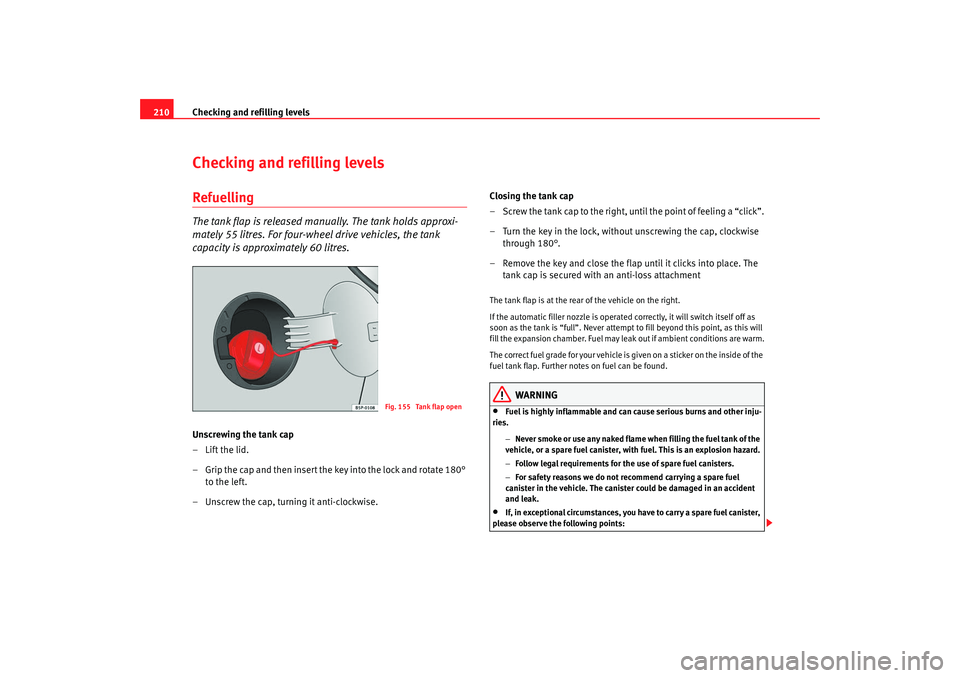
Checking and refilling levels
210Checking and refilling levelsRefuellingThe tank flap is released manually. The tank holds approxi-
mately 55 litres. For four-wheel drive vehicles, the tank
capacity is approximately 60 litres.Unscrewing the tank cap
–Lift the lid.
– Grip the cap and then insert the key into the lock and rotate 180°
to the left.
– Unscrew the cap, turning it anti-clockwise. Closing the tank cap
– Screw the tank cap to the right, until the point of feeling a “click”.
– Turn the key in the lock, without unscrewing the cap, clockwise
through 180°.
– Remove the key and close the flap until it clicks into place. The tank cap is secured with an anti-loss attachment
The tank flap is at the rear of the vehicle on the right.
If the automatic filler nozzle is operated correctly, it will switch itself off as
soon as the tank is “full”. Never attempt to fill beyond this point, as this will
fill the expansion chamber. Fuel may leak out if ambient conditions are warm.
The correct fuel grade for your vehicle is given on a sticker on the inside of the
fuel tank flap. Further notes on fuel can be found.
WARNING
•
Fuel is highly inflammable and can cause serious burns and other inju-
ries.
−Never smoke or use any naked flame when filling the fuel tank of the
vehicle, or a spare fuel canister, with fuel. This is an explosion hazard.
− Follow legal requirements for the use of spare fuel canisters.
− For safety reasons we do not recommend carrying a spare fuel
canister in the vehicle. The canister could be damaged in an accident
and leak.
•
If, in exceptional circumstances, you have to carry a spare fuel canister,
please observe the following points:
Fig. 155 Tank flap open
AlteaXL_EN.book Seite 210 M ontag, 2. Februar 2009 12:26 12
Page 236 of 297
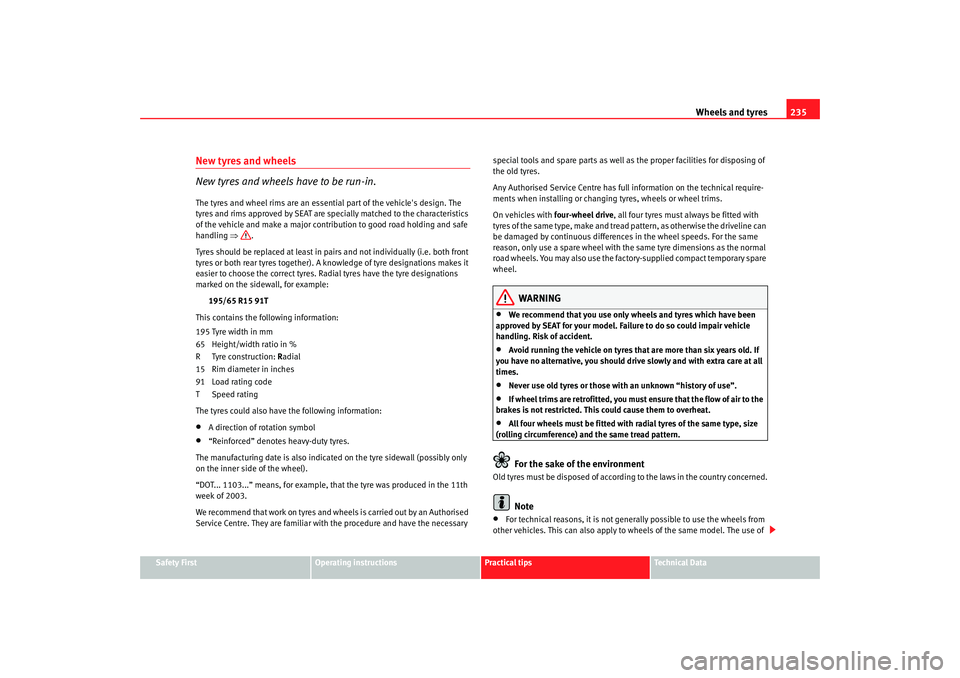
Wheels and tyres235
Safety First
Operating instructions
Practical tips
Te c h n i c a l D a t a
New tyres and wheels
New tyres and wheels have to be run-in.The tyres and wheel rims are an essential part of the vehicle's design. The
tyres and rims approved by SEAT are specially matched to the characteristics
of the vehicle and make a major contribution to good road holding and safe
handling ⇒.
Tyres should be replaced at least in pairs and not individually (i.e. both front
tyres or both rear tyres together). A knowledge of tyre designations makes it
easier to choose the correct tyres. Radial tyres have the tyre designations
marked on the sidewall, for example: 195/65 R15 91T
This contains the following information:
195 Tyre width in mm
65 Height/width ratio in %
R Tyre construction: Radial
15 Rim diameter in inches
91 Load rating code
T Speed rating
The tyres could also have the following information:•
A direction of rotation symbol
•
“Reinforced” denotes heavy-duty tyres.
The manufacturing date is also indicated on the tyre sidewall (possibly only
on the inner side of the wheel).
“DOT... 1103...” means, for example, that the tyre was produced in the 11th
week of 2003.
We recommend that work on tyres and wheels is carried out by an Authorised
Service Centre. They are familiar with the procedure and have the necessary special tools and spare parts as well as the proper facilities for disposing of
the old tyres.
Any Authorised Service Centre has full information on the technical require-
ments when installing or changing tyres, wheels or wheel trims.
On vehicles with
four-wheel drive, all four tyres must always be fitted with
tyres of the same type, make and tread pattern, as otherwise the driveline can
be damaged by continuous differences in the wheel speeds. For the same
reason, only use a spare wheel with the same tyre dimensions as the normal
road wheels. You may also use the factory-supplied compact temporary spare
wheel.
WARNING
•
We recommend that you use only wh eels and tyres which have been
approved by SEAT for your model. Failure to do so could impair vehicle
handling. Risk of accident.
•
Avoid running the vehicle on tyres th at are more than six years old. If
you have no alternative, you should drive slowly and with extra care at all
times.
•
Never use old tyres or those with an unknown “history of use”.
•
If wheel trims are retrofitted, you must ensure that the flow of air to the
brakes is not restricted. This could cause them to overheat.
•
All four wheels must be fitted with radial tyres of the same type, size
(rolling circumference) and the same tread pattern.For the sake of the environment
Old tyres must be disposed of accordi ng to the laws in the country concerned.
Note
•
For technical reasons, it is not generally possible to use the wheels from
other vehicles. This can also apply to wheels of the same model. The use of
AlteaXL_EN.book Seite 235 M ontag, 2. Februar 2009 12:26 12
Page 237 of 297
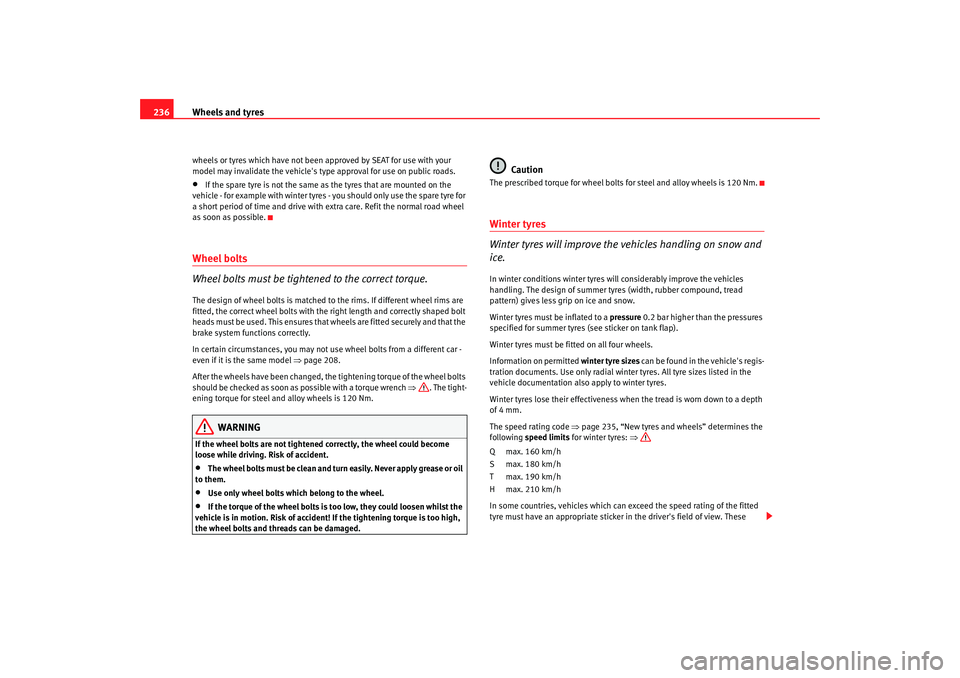
Wheels and tyres
236wheels or tyres which have not been approved by SEAT for use with your
model may invalidate the vehicle's type approval for use on public roads.•
If the spare tyre is not the same as the tyres that are mounted on the
vehicle - for example with winter tyres - you should only use the spare tyre for
a short period of time and drive with extra care. Refit the normal road wheel
as soon as possible.
Wheel bolts
Wheel bolts must be tightened to the correct torque.The design of wheel bolts is matched to the rims. If different wheel rims are
fitted, the correct wheel bolts with the right length and correctly shaped bolt
heads must be used. This ensures that wheels are fitted securely and that the
brake system functions correctly.
In certain circumstances, you may not use wheel bolts from a different car -
even if it is the same model ⇒page 208.
After the wheels have been changed, the tightening torque of the wheel bolts
should be checked as soon as possible with a torque wrench ⇒. The tight-
ening torque for steel and alloy wheels is 120 Nm.
WARNING
If the wheel bolts are not tightened correctly, the wheel could become
loose while driving. Risk of accident.•
The wheel bolts must be clean and turn easily. Never apply grease or oil
to them.
•
Use only wheel bolts which belong to the wheel.
•
If the torque of the wheel bolts is to o low, they could loosen whilst the
vehicle is in motion. Risk of accident! If the tightening torque is too high,
the wheel bolts and threads can be damaged.
Caution
The prescribed torque for wheel bolts for steel and alloy wheels is 120 Nm.Winter tyres
Winter tyres will improve the vehicles handling on snow and
ice.In winter conditions winter tyres will considerably improve the vehicles
handling. The design of summer ty res (width, rubber compound, tread
pattern) gives less grip on ice and snow.
Winter tyres must be inflated to a pressure 0.2 bar higher than the pressures
specified for summer tyres (see sticker on tank flap).
Winter tyres must be fitted on all four wheels.
Information on permitted winter tyre sizes can be found in the vehicle's regis-
tration documents. Use only radial winter tyres. All tyre sizes listed in the
vehicle documentation also apply to winter tyres.
Winter tyres lose their effectiveness when the tread is worn down to a depth
of 4 mm.
The speed rating code ⇒page 235, “New tyres and wheels” determines the
following speed limits for winter tyres: ⇒
Q max. 160 km/h
S max. 180 km/h
T max. 190 km/h
H max. 210 km/h
In some countries, vehicles which can exceed the speed rating of the fitted
tyre must have an appropriate sticker in the driver's field of view. These
AlteaXL_EN.book Seite 236 M ontag, 2. Februar 2009 12:26 12
Page 238 of 297

Wheels and tyres237
Safety First
Operating instructions
Practical tips
Te c h n i c a l D a t a
stickers are available from your Authorised Service Centre. The legal require-
ments of each country must be followed.
Do not have winter tyres fitted for u
nnecessarily long periods. Vehicles with
summer tyres handle better when the roads are free of snow and ice.
If you have a flat tyre, please refer to the notes on the spare wheel
⇒ page 235, “New tyres and wheels”.
WARNING
The maximum speed for the winter tyre s must not be exceeded. Otherwise,
this could lead to tyre damage and thus, an accident risk.
For the sake of the environment
Fit your summer tyres in good time. They are quieter, do not wear so quickly
and reduce fuel consumption.Snow chainsSnow chains are only permitted on the front wheels and only for
tyres195/65R15 and 205/55R16. These tyres may only be fitted with fine-
pitch link chains which do not protrude more than 15 mm ⇒page 235.
Snow chains must have fine-pitch link s which do not protrude more than 9
mm, including tension device.
Remove wheel hub covers and trim rings before fitting snow chains. For safety
reasons cover caps, available in any Authorised Service Centre, must then be
fitted over the wheel bolts.
Four-wheel drive : where snow chains are compulsory on certain roads, this
normally also applies to cars with four-wheel drive. Snow chains may only be
fitted to the front wheels (also on vehicles with four-wheel drive).
WARNING
Snow chains should be correctly tightened in accordance with the manu-
facturer's instructions. This will prevent the chains coming into contact
with the wheel housing.
Caution
You must remove the snow chains to drive on roads which are free of snow.
Otherwise they will impair handling, damage the tyres and wear out very
quickly.
Note
•
In some countries, the speed limit for using snow chains is 50 km/h. The
legal requirements of the country should be followed.
•
We recommend that you ask your Appr oved Service Centre for information
about appropriate wheel, tyre and snow chain size.
AlteaXL_EN.book Seite 237 M ontag, 2. Februar 2009 12:26 12
Page 291 of 297
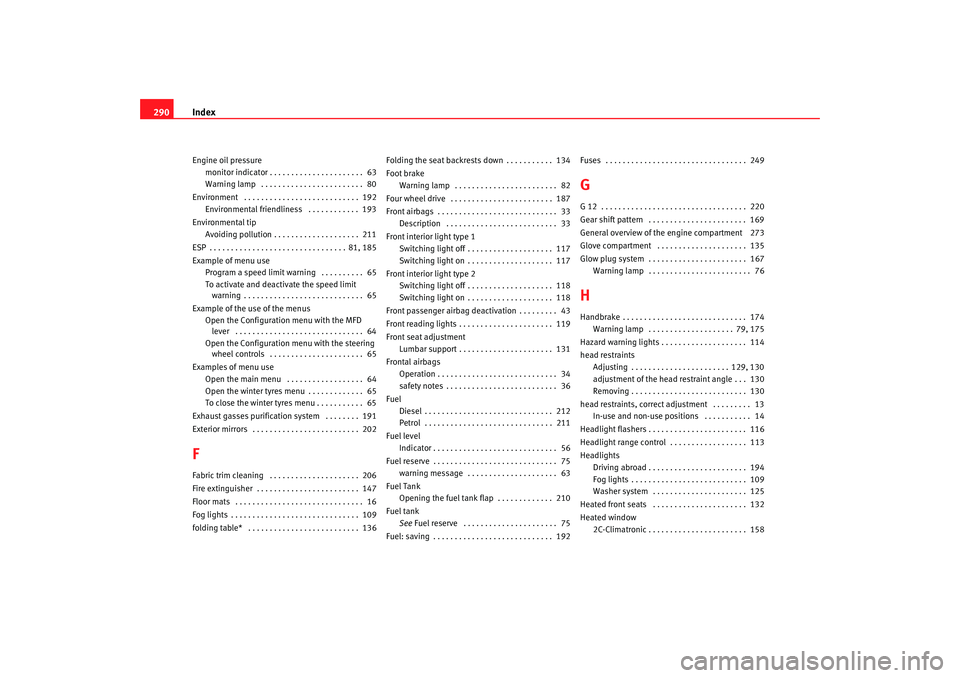
Index
290Engine oil pressure
monitor indicator . . . . . . . . . . . . . . . . . . . . . . 63
Warning lamp . . . . . . . . . . . . . . . . . . . . . . . . 80
Environment . . . . . . . . . . . . . . . . . . . . . . . . . . . 192 Environmental friendliness . . . . . . . . . . . . 193
Environmental tip Avoiding pollution . . . . . . . . . . . . . . . . . . . . 211
ESP . . . . . . . . . . . . . . . . . . . . . . . . . . . . . . . . 81, 185
Example of menu use Program a speed limit warning . . . . . . . . . . 65
To activate and deactivate the speed limit warning . . . . . . . . . . . . . . . . . . . . . . . . . . . . 65
Example of the use of the menus Open the Configuration menu with the MFD lever . . . . . . . . . . . . . . . . . . . . . . . . . . . . . . 64
Open the Configuration menu with the steering wheel controls . . . . . . . . . . . . . . . . . . . . . . 65
Examples of menu use Open the main menu . . . . . . . . . . . . . . . . . . 64
Open the winter tyres menu . . . . . . . . . . . . . 65
To close the winter tyres menu . . . . . . . . . . . 65
Exhaust gasses purification system . . . . . . . . 191
Exterior mirrors . . . . . . . . . . . . . . . . . . . . . . . . . 202FFabric trim cleaning . . . . . . . . . . . . . . . . . . . . . 206
Fire extinguisher . . . . . . . . . . . . . . . . . . . . . . . . 147
Floor mats . . . . . . . . . . . . . . . . . . . . . . . . . . . . . . 16
Fog lights . . . . . . . . . . . . . . . . . . . . . . . . . . . . . . 109
folding table* . . . . . . . . . . . . . . . . . . . . . . . . . . 136 Folding the seat backrests down . . . . . . . . . . . 134
Foot brake
Warning lamp . . . . . . . . . . . . . . . . . . . . . . . . 82
Four wheel drive . . . . . . . . . . . . . . . . . . . . . . . . 187
Front airbags . . . . . . . . . . . . . . . . . . . . . . . . . . . . 33 Description . . . . . . . . . . . . . . . . . . . . . . . . . . 33
Front interior light type 1 Switching light off . . . . . . . . . . . . . . . . . . . . 117
Switching light on . . . . . . . . . . . . . . . . . . . . 117
Front interior light type 2 Switching light off . . . . . . . . . . . . . . . . . . . . 118
Switching light on . . . . . . . . . . . . . . . . . . . . 118
Front passenger airbag deactivation . . . . . . . . . 43
Front reading lights . . . . . . . . . . . . . . . . . . . . . . 119
Front seat adjustment Lumbar support . . . . . . . . . . . . . . . . . . . . . . 131
Frontal airbags Operation . . . . . . . . . . . . . . . . . . . . . . . . . . . . 34
safety notes . . . . . . . . . . . . . . . . . . . . . . . . . . 36
Fuel Diesel . . . . . . . . . . . . . . . . . . . . . . . . . . . . . . 212
Petrol . . . . . . . . . . . . . . . . . . . . . . . . . . . . . . 211
Fuel level Indicator . . . . . . . . . . . . . . . . . . . . . . . . . . . . . 56
Fuel reserve . . . . . . . . . . . . . . . . . . . . . . . . . . . . . 75 warning message . . . . . . . . . . . . . . . . . . . . . 63
Fuel Tank Opening the fuel tank flap . . . . . . . . . . . . . 210
Fuel tank See Fuel reserve . . . . . . . . . . . . . . . . . . . . . . 75
Fuel: saving . . . . . . . . . . . . . . . . . . . . . . . . . . . . 192 Fuses . . . . . . . . . . . . . . . . . . . . . . . . . . . . . . . . . 249
GG 12 . . . . . . . . . . . . . . . . . . . . . . . . . . . . . . . . . . 220
Gear shift pattern . . . . . . . . . . . . . . . . . . . . . . . 169
General overview of the engine compartment 273
Glove compartment . . . . . . . . . . . . . . . . . . . . . 135
Glow plug system . . . . . . . . . . . . . . . . . . . . . . . 167
Warning lamp . . . . . . . . . . . . . . . . . . . . . . . . 76HHandbrake . . . . . . . . . . . . . . . . . . . . . . . . . . . . . 174Warning lamp . . . . . . . . . . . . . . . . . . . . 79, 175
Hazard warning lights . . . . . . . . . . . . . . . . . . . . 114
head restraints Adjusting . . . . . . . . . . . . . . . . . . . . . . . 129, 130
adjustment of the head restraint angle . . . 130
Removing . . . . . . . . . . . . . . . . . . . . . . . . . . . 130
head restraints, correct adjustment . . . . . . . . . 13 In-use and non-use positions . . . . . . . . . . . 14
Headlight flashers . . . . . . . . . . . . . . . . . . . . . . . 116
Headlight range control . . . . . . . . . . . . . . . . . . 113
Headlights Driving abroad . . . . . . . . . . . . . . . . . . . . . . . 194
Fog lights . . . . . . . . . . . . . . . . . . . . . . . . . . . 109
Washer system . . . . . . . . . . . . . . . . . . . . . . 125
Heated front seats . . . . . . . . . . . . . . . . . . . . . . 132
Heated window 2C-Climatronic . . . . . . . . . . . . . . . . . . . . . . . 158
AlteaXL_EN.book Seite 290 M ontag, 2. Februar 2009 12:26 12